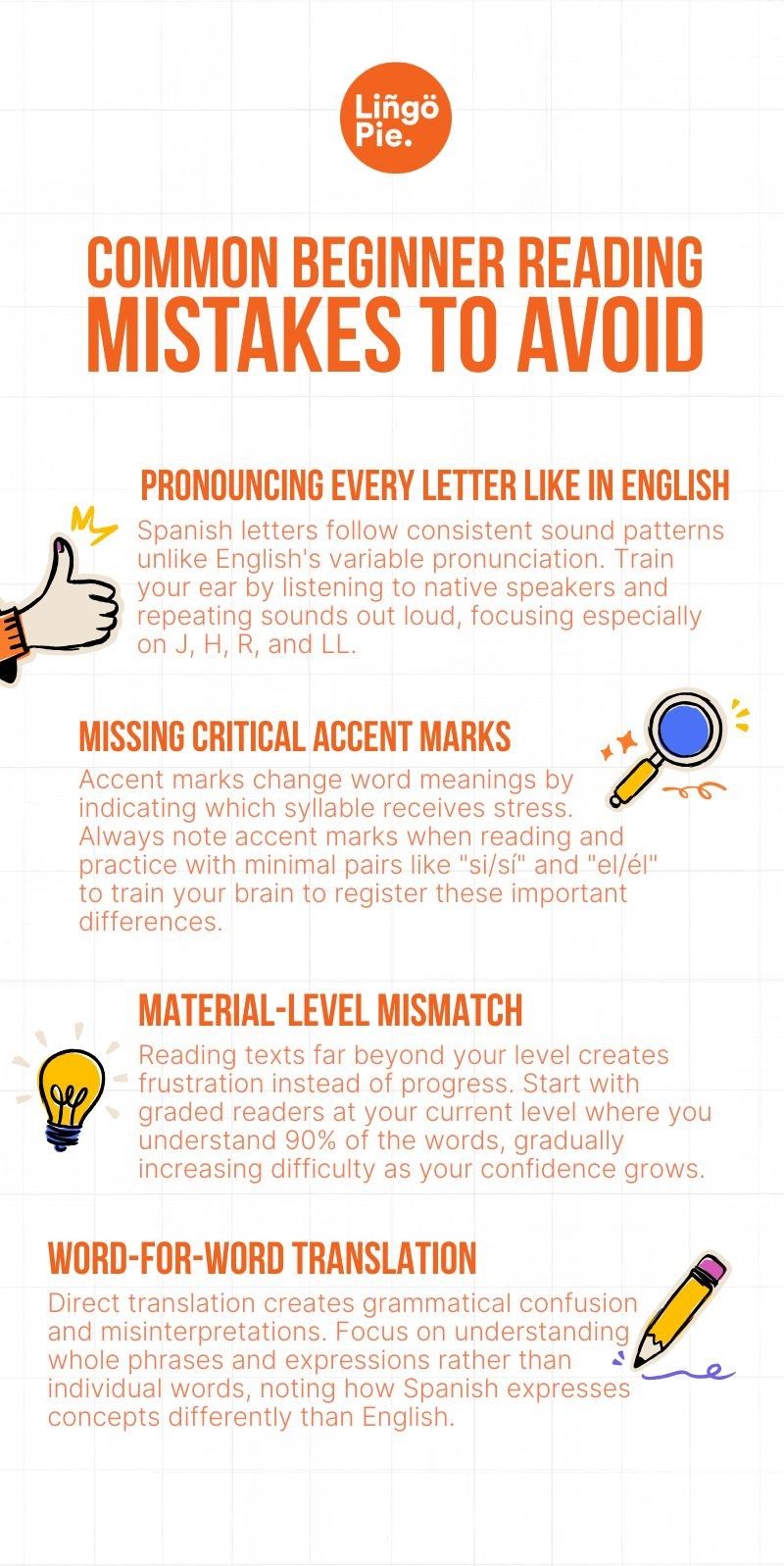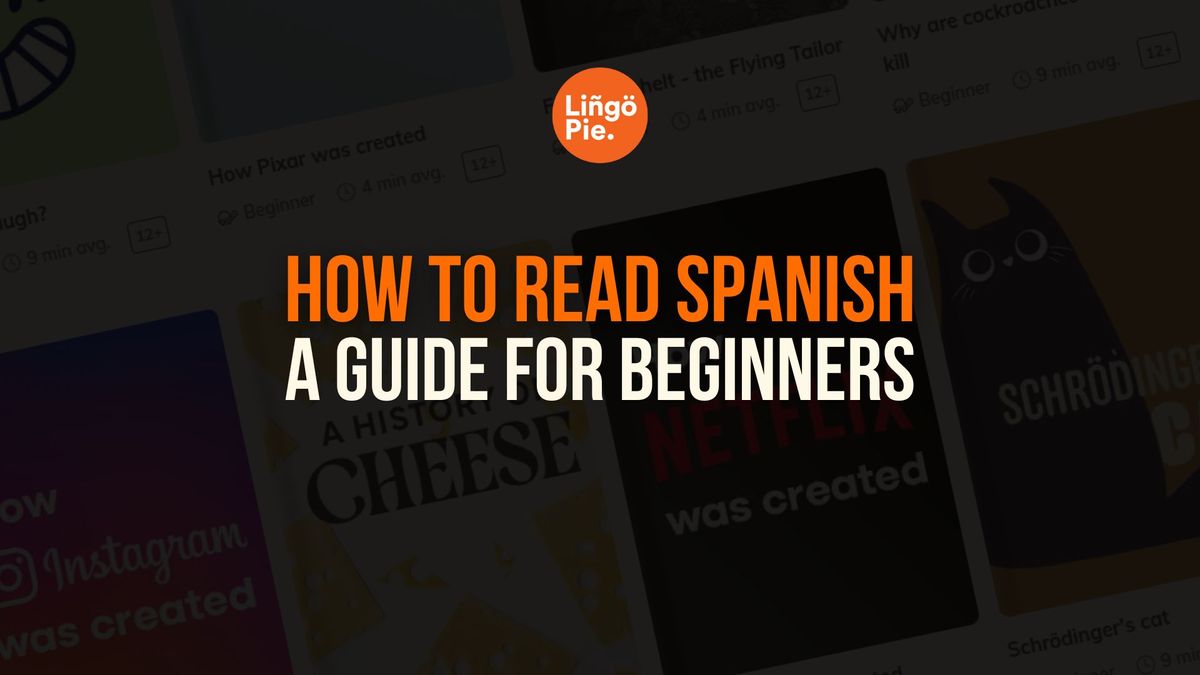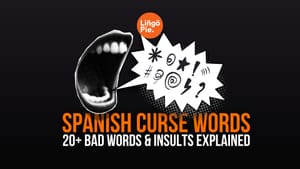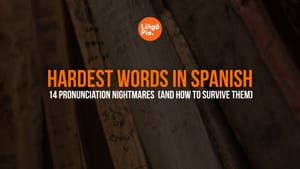Jumping into reading in Spanish might feel like the deep end at first, but it's actually one of the best ways to improve your Spanish fast! Instead of getting stuck in boring grammar drills, Spanish reading puts you directly in touch with everything from catchy song lyrics to hilarious memes—connecting you with real Spanish as it's actually used today.
In this post, I'll break down exactly how to start your Spanish reading journey. You'll get to learn why Spanish is actually much easier to read than English (thanks to its phonetic nature), discover which texts won't make you reach for Google Translate every two seconds, and get practical techniques for understanding what you're reading without getting stuck on every unfamiliar word.
- Question Words In Spanish: All You Need to Know About
- 17+ Spanish Terms of Endearment To Use With Your Fam
- Learn Spanish With These 5 Spanish Language Experts

Why You Should Start Reading In Spanish
Learners should start reading in Spanish because it can expose you to authentic language in context. Rather than learning isolated rules or words, reading helps you see how Spanish works naturally and builds multiple skills simultaneously. To convince you further, here are the top reasons you must consider.
1. Natural Grammar Understanding
Reading shows you grammar patterns in real use instead of abstract rules. You'll see how articles connect with nouns, how verb tenses flow together, and how sentence structures work—all in meaningful contexts that help your brain internalize these patterns naturally. This practical exposure helps you develop an intuitive feel for Spanish grammar rather than memorizing endless rules.
2. Vocabulary Growth That Sticks
When you learn words through reading, you remember them better because you see them used in context. Each new word has a purpose in the story or article, creating stronger memory connections in your brain. You'll also discover everyday expressions, Spanish slang, and phrases that rarely appear in textbooks but are essential for natural communication.
3. Direct Spanish Processing
Regular reading trains your brain to understand Spanish directly instead of mentally translating everything to English first. This crucial mental shift develops as you become comfortable with Spanish sentence structures and thought patterns, leading to more natural comprehension and eventually helping your speaking abilities too.
4. Cultural Context and Understanding
Language and culture are inseparable. Through reading, you'll gain insights into traditions, humor, history, and perspectives from Spanish-speaking communities. This cultural knowledge enriches your understanding of why certain expressions exist and what they truly mean to native speakers, giving depth and authenticity to your language skills.
5. Practical Conversation Readiness
Reading provides you with a collection of phrases, expressions, and sentence patterns you can use in real Spanish conversations. This exposure to natural language flow builds your confidence for speaking situations, as you'll have encountered many useful language structures before you need to produce them yourself. Many learners find their speaking becomes more fluid and natural after consistent reading practice.

How To Read Spanish
Unlike some languages with complex writing systems, Spanish uses the familiar Latin alphabet with just a few additions, making it surprisingly accessible for English speakers. The best part? Spanish words are spelled exactly as they sound, so once you learn the pronunciation rules, you can correctly read almost any Spanish word you encounter!
While it might seem challenging at first, Spanish reading is actually easier than English in many ways. English has about 20 different sounds for our five vowels, while Spanish vowels are consistent with just one sound each. This consistency means you'll progress much faster in your reading journey than you might expect.
To develop your Spanish reading skills, it's is recommended to start with 2 things: reading Spanish letters and letters with tilde.
Reading Spanish Letters
The Spanish alphabet is your foundation for reading success. It consists of 27 letters, similar to the English alphabet but with a few key differences, including the unique letter "ñ". Once you understand how each letter sounds, you'll be well on your way to reading fluently.
For beginners in Spanish, focus on the vowels first. The good news is that Spanish vowels always make the same sound, no matter where they appear in a word. Here's how to pronounce each one:
- A: "ah" as in "father"
- E: "eh" as in "bed"
- I: "ee" as in "see"
- O: "oh" as in "go"
- U: "oo" as in "blue"
Now, let's move to consonants. Most Spanish consonants sound similar to English, with a few key differences that'll make you sound like a natural:
- H: Always silent! "Hola" sounds like "OH-lah" – the h is just for decoration.
- J: Makes a sound like you're clearing your throat gently – similar to the English "h" but stronger (jamón = hah-MOHN)
- LL: Depending on the region, sounds like the "y" in "yes" or like a soft "j" in "Jacques" (calle = KAH-yeh)
- Ñ: The squiggly n makes a "ny" sound like in "canyon" (niño = NEE-nyoh)
- B and V: Here's a secret native speakers know - these two letters sound identical in Spanish! Both make a soft "b" sound (vaca = BAH-kah)
- C: Changes personality depending on its friends – before e/i it sounds like "s", otherwise like "k" (cine = SEE-neh, casa = KAH-sah)
Reading Spanish Letters With Tilde
The tilde (accent mark) is a crucial part of Spanish reading that many beginners overlook. Accent marks are extremely important to Spanish pronunciation. Misplacing or forgetting an accent can make a big difference in the meaning of your Spanish sentences.
For example, these words look almost identical but have completely different meanings:
- Si (If) vs. Sí (Yes)
- Tu (Your) vs. Tú (You)
- El (The) vs. Él (He)
- Mi (My) vs. Mí (Me)
The accent mark tells you which syllable to stress when reading the word aloud. Understanding Spanish stress rules will significantly improve your reading:
- Words ending in a vowel, N, or S (without written accent): Stress the second-to-last syllable Example: nada (NA-da), meaning "nothing"
- Words ending in other consonants (without written accent): Stress the final syllable Example: cantar (can-TAR), meaning "to sing"
- Words with written accents (tildes): Always stress the syllable with the accent Example: rápido (RÁ-pi-do), meaning "fast"
- Words ending with -mente: Have two stressed syllables - one on the original adjective and one on "men" in -mente Example: rápidamente (RÁ-pi-da-MEN-te), meaning "quickly"
By mastering these fundamentals of Spanish letter reading, you'll quickly develop the confidence to read Spanish texts of increasing complexity. Remember that practice makes perfect - the more you read, the more natural it will become!
How To Improve Your Spanish Reading Skills
Once you've mastered basic Spanish pronunciation, you're ready to build your reading skills through practice with actual Spanish texts. In my experience, the right materials can make a huge difference in terms of motivation and education.

Read Spanish Short Stories
Spanish short stories written for beginners offer an ideal starting point for developing your reading skills. These stories typically use:
- Simple vocabulary that repeats throughout the text
- Basic sentence structures
- Present tense verbs
- Everyday situations you'll encounter in real life
Lingopie's Short Stories collection provides beginner-friendly stories that gradually introduce new words while reinforcing those you already know. The platform allows you to both read and listen to stories, helping you connect written words with their pronunciations.
Set aside just 2 to 5 minutes daily to read a short story. This small but consistent practice builds your vocabulary, helps you recognize common phrases, and trains your brain to understand Spanish sentence patterns naturally.

Read Spanish Subtitles While Watching
Combining Spanish videos with Spanish subtitles creates a powerful learning opportunity. This method connects written words with native pronunciation and shows how language works in real situations.
When watching with subtitles:
- Read the subtitle before the speaker says the line
- Pause to check unfamiliar words
- Notice how written Spanish connects to spoken Spanish
- Pay attention to sentence patterns that repeat
The best part? You can use Lingopie's dual subtitle feature for improving your Spanish! This feature allows you to click on any word for an instant translation, helping you learn new vocabulary without losing the flow of the content. This approach keeps you engaged while building your reading skills.
Read News In Easy Spanish
Reading news articles written in simplified Spanish bridges the gap between beginner materials and authentic content. These articles use:
- Controlled vocabulary
- Clearer sentence structures
- Current topics that keep you interested
- Real-world language you'll use in conversations
Lingopie's News in Easy Spanish feature provides current events articles written specifically for language learners. The news format introduces useful vocabulary about politics, culture, sports, and global events while keeping the language accessible.
Reading news in easy Spanish connects your language learning to real-world topics, making your practice more relevant and motivating.
Turn The Page On Traditional Learning With Lingopie
Ready to put your Spanish reading skills into action? Reading from textbooks can only take you so far. What you need is a bridge between learning and living the language.
That's exactly what Lingopie offers. With our specially designed Short Stories collection, dual subtitle technology, and Easy Spanish News feature, you'll find everything you need to make Spanish reading a natural part of your day.
Why not experience the difference yourself? Start your reading journey today with Lingopie's 7-day free trial and discover how natural, enjoyable, and effective learning a language can be when you're actually having fun.
¡Vamos a leer juntos! (Let's read together!)









![Months And Dates In Spanish: A Beginner’s Guide [2025]](/blog/content/images/size/w300/2025/05/Months-dates-in-spanish.jpg)